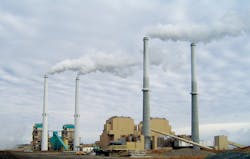Power Plant Reuse
The PPL Montana (PPLM) Colstrip Steam Electric Station is a 2,276-MW coal-fired power plant located in Colstrip, Mont. It consumes 10 million tons of coal per year, which is harvested at the nearby Rosebud Mine in Colstrip. During daily operation of the power plant, up to 14 million gal of raw water from the Yellowstone River is pumped 30 miles to Colstrip for plant use.
The plant is permitted as a zero-discharge facility. The zero-discharge design and plant operation have resulted in numerous storage ponds at the power plant site, with about 1 billion gal of inventory. This excess inventory is threatening the plant’s operation. PPLM staff determined the need to reduce the inventory by 750 million gal with a treatment system—one operational within a year and capable of meeting the goal within five years. Reusing water internal to the system permits a reduction of raw water introduced to the system, as well as a reduction in the stored water inventory.
Initial Assessment
A review of the raw water quality and treated water requirements revealed several issues. All of the potential source waters are high in specific conductance, total dissolved solids (TDS), calcium, magnesium and sulfate. Substantial TDS removal is necessary to meet the treated water requirements of about 1,000 to 2,000 µS/cm.
Multiple technologies were investigated to determine their effectiveness in treating the identified source water. Two proven treatment technologies—membrane treatment and evaporation/crystallization—were determined to provide a treated water meeting the specific conductance requirement for these conditions. Other mature technologies (e.g., ion exchange, electrodialysis and thermal evaporation) had inherent qualities that, upon initial investigation, rendered them unsuitable for this application.
MF RO
The tight time frame of the project led to a more traditional treatment approach of microfiltration (MF) membranes followed by reverse osmosis (RO) membranes. The hardness of even the highest-quality waters would require softening for pretreatment. Bench tests were completed that resulted in two-stage softening with high lime and soda ash chemical doses. The two-stage softening followed by MF/RO would be an effective treatment process, but the high chemical doses and potential complex operations for the power plant staff led to further investigations.
A modified budgeting timetable allowed for evaluation of emerging technologies. A vibratory shear enhanced processing (VSEP) membrane technology that used little to no chemical pretreatment, required minimal manpower to operate and provided high-quality product water was applicable to the PPLM Colstrip conditions.
VSEP, manufactured by New Logic Research, uses membrane filtration such as nanofiltration (NF) or RO with one fundamental modification. The filtration method incorporates torsional vibrating action to hinder contact fouling of the membrane. The vibration discourages sustained corruption of the membrane’s pore structure by solid matter. The ability to separate concentrated solid solutions from water alleviates the chemical coagulation and precipitation pretreatment requirement inherent to RO technology.
Pilot-Testing Results
A pilot test was conducted during the period from late June to late October 2008. The pilot was run in different modes to determine the optimum system operation. The approach was to start at a low recovery and work toward the highest recovery achievable in which the required cleanings were at least five days apart.
It was found that 75% recovery at 210 psi achieved the desired permeate quality with cleaning required about every five days. Figure 1 shows the feed water, permeate and concentrate water quality at the optimum pilot unit settings. The permeate conductivity of 1,400 µS/cm using an NF membrane is adequate to introduce permeate into the raw water feed to the plant. The concentrate conductivity averaged about 10,500 µS/cm. The concentrate of this water quality can be routed to one of the onsite evaporation ponds that has a conductivity of more than 15,000 µS/cm.
It had become evident a few weeks into the pilot study that the VSEP technology was going to meet the water treatment goals based on the water quality and flux. A full-scale plant design was initiated to include five VSEP NF membrane modules (expandable to eight modules) plus all of the ancillary components. Results of the pilot indicated that one membrane module should treat an average of about 45 gal per minute with a 75% recovery.
The NF-270 NF membranes selected are not capable of rejecting monovalent ions such as sodium and chloride. If the feed water characteristics change in the future or if the permeate conductivity is not reaching desired water quality, different membranes may need to be investigated.
Short-term piloting with energy-saving polyamide RO membranes showed significant ion rejection, but the pilot needed excessive cleaning when using these membranes. Another approach taken was to plan for the future installation of a traditional spiral-wound RO membrane system following the VSEP process. This would allow for removal of the larger ions in the VSEP units and polishing for monovalent ions in the RO polishing stage, resulting in a very low permeate conductivity without extensive cleaning of the polishing membranes.
Performance & Projection
The installation of the VSEP membrane system resulted in a technology that would successfully meet the goals of the project. The full-scale VSEP installation currently is providing the following water quality: an average conductivity of 1,600 µS/cm at 75% recovery.
This permeate water quality allows the water to be used at various points in the power plant process. The addition of the two additional full-scale plants in successive years will result in a net treated water volume of about 750 million gal over the next four to five years, effectively reducing the storage pond inventory.
Download: Here
